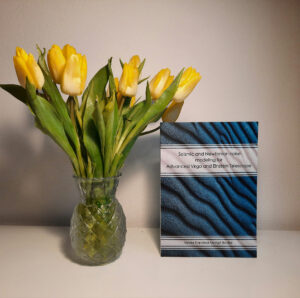Maria Bader wins the Jan Kluyver Prize 2021 for the best English-language summary in her thesis on seismic noise models for gravity wave detectors such as Advanced Virgo and the future Einstein Telescope, possibly in Limburg.
This was announced on Wednesday 15 December by jury chairman Prof Jos Engelen, former director of Nikhef. The prize is accompanied by a sum of EUR 2500. The jury of former directors of the institute examined a total of 22 theses.

The jury praised her summary because it explains the state of the art in measuring gravitational waves in an exemplary way. Bader herself calls the summary a chance to give coherence to her adventures as a researcher, also for family and friends. “Normally I leave my work at work, I don’t talk about it very much, especially the physics behind it. I hoped readers will feel like actually opening the book.”
Bader was trained as a physicist in Munich, but came to the Netherlands for her Master’s studies. Via Utrecht, she ended up at Nikhef in Amsterdam, where she worked as a student on the XAMS test project for dark matter detector XENON1T/nT.
That she then ended up in gravity waves is not very illogical, says Bader. “XENON had no vacancies for PhDs. But I was also fascinated from an early age with the question of how the universe works. That started with particles and eventually became astrophysics and the detection of gravitational waves from dark holes.”
Bader hit it off. “Two weeks after I started my PhD, LIGO and Virgo detected the first gravitational wave. The field was bursting with energy. What else were we going to discover? What else was possible? I actually got carried away automatically.”
In her thesis, she describes how vibrations from the bottom of a gravitational wave detector can be modeled with computers. This is important in order to distinguish real space vibrations from the universe from ambient noise in the detectors. In addition to physics, her research was therefore partly geology.
For her research she did, among other things, a measurement campaign with dozens of vibration transducers in the fields around the Advanced Virgo detector near Pisa in Italy. “Very practical work, and quite exciting too, because just try to find the sensors all over again in the mud after a few weeks.”
Bader has been working as a risk modeller at ABN-Amro since 2020. Fascinating work, she thinks. “Still it’s about data and about modeling, but in a completely different environment. I find it interesting to work in the business world. We are results-oriented at all levels. Things definitely move faster here than in academia and I actually like that. Here and there, science can even learn something from that, I think.”
Maria Bader plans to use the money from the Kluyver Prize for a trip to Latin America. “I am a fanatical salsa dancer, but have never been there. Now that’s finally going to happen.”
(interview Martijn van Calmthout)
Read about all the Jan Kluyver prize winners over the years
Watch the PAPERCLIP video with Maria: